Hagia Sophia is a historical and architectural landmark in Istanbul, Turkey. The Byzantine emperor Justinian I built it as a Christian basilica in the 6th century. It is considered the most important Byzantine structure in the world and one of its great monuments. Hagia Sophia has a unique history that reflects Istanbul’s cultural and religious changes. It served as an Eastern Orthodox church for almost a thousand years until the Crusaders converted it into a Catholic church in 1204. In 1453, it became a mosque when the Ottomans conquered Constantinople. In 1935, it was turned into a museum by the Turkish Republic. In 2020, it was reopened as a mosque again. Hagia Sophia is famous for its impressive dome, which spans 102 feet (31 meters) and rises 180 feet (55 meters) above the ground. It was the largest dome in the world for centuries and a masterpiece of engineering and art. The interior of Hagia Sophia is decorated with marble, mosaics, calligraphy, and paintings that reflect the Byzantine and Ottoman styles. The building also contains tombs, fountains, a library, and a madrasa (Islamic school). Hagia Sophia is open to visitors daily, except on Fridays when it is closed for prayers. The admission fee for foreign visitors is $4 (€3.64, £3.48) per person, while an audio guide costs $1.2 (€1.09, £1.04) per person. Hagia Sophia is located in the Sultanahmet district of Istanbul, near the Topkapi Palace and the Blue Mosque. It is easily accessible by public transportation or taxi.
What is the Hagia Sophia?
Hagia Sophia is a historical site located in Istanbul, Turkey. It was originally built as a church and later converted into a mosque. The structure is now officially known as the Hagia Sophia Grand Mosque. Hagia Sophia was constructed between the years 532 and 537 AD. It was commissioned by the Byzantine Emperor Justinian I as a Christian cathedral. The building has undergone several additions and modifications over the centuries. The Hagia Sophia has impressive dimensions. It measures 180 feet (55 meters) in height, 269 feet (82 meters) in length, and 240 feet (73 meters) in width. The Hagia Sophia was designed by architects Anthemius of Tralles and Isidore of Miletus. They created a monumental structure with a unique architectural style that blends elements of Byzantine and Islamic influences. The building features a large dome, a significant engineering achievement.
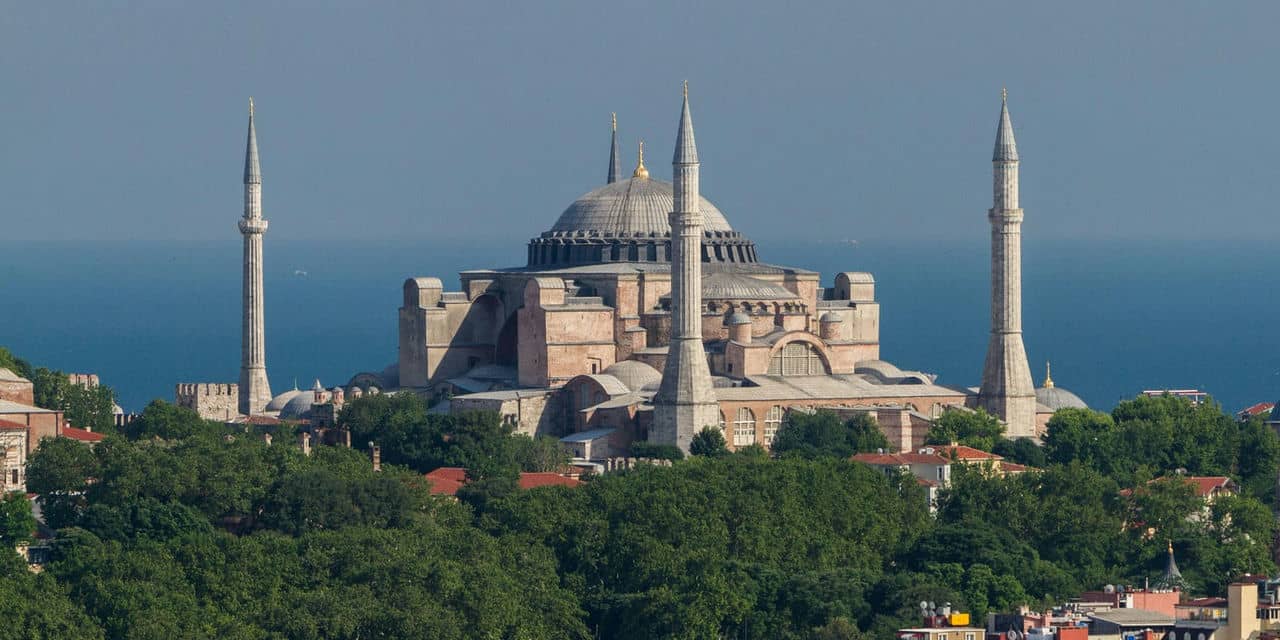
What architectural style is most prominent in Hagia Sophia?
The architectural style that is most prominent in the Hagia Sophia is a fusion of Byzantine and Islamic influences. The Byzantine influence is evident in the overall design and layout of the Hagia Sophia. It features a large central dome, a characteristic feature of Byzantine architecture. The dome is supported by a series of arches and pendentives, creating a sense of grandeur and spaciousness within the interior. Intricate mosaics and decorative motifs fill the walls and ceilings, showcasing the Byzantine artistic style. Islamic architectural elements were introduced when the Hagia Sophia was converted into a mosque. These additions include the addition of mihrabs (prayer niches) and minarets, which are characteristic features of Islamic places of worship.
What structural engineering principles are employed in the construction of the Hagia Sophia?
4 major structural engineering principles were employed in the construction of the Hagia Sophia. Firstly, the Hagia Sophia utilizes a central dome supported by arches and pendentives. The architectural feature distributes the dome’s weight and allows for a spacious interior. Arches and pendentives transfer the load from the dome to the supporting structures, providing stability and structural integrity. Secondly, buttresses and semi-domes were incorporated into the design of the Hagia Sophia. Buttresses are external supports that help counteract the lateral forces exerted on the walls, preventing them from collapsing. The semi-domes provide additional support to the main dome and help distribute the weight to the supporting structures, ensuring the overall stability of the monument. Thirdly, using materials such as stone and brick contributed to the structural strength of the Hagia Sophia. The walls were constructed with thick layers of stone and brick, providing a solid foundation for the entire structure. The combination of these materials and the careful construction techniques ensured the monument’s resilience and longevity. Lastly, the Hagia Sophia employed innovative construction techniques for its time. The architects used precise calculations and measurements to achieve the desired structural stability. Advanced techniques, such as incorporating hidden iron clamps, helped reinforce the structure and enhance its resistance to external forces.
Who designed the Hagia Sophia?
The Hagia Sophia was designed by two architects, Anthemius of Tralles and Isidore of Miletus. These skilled architects were commissioned by the Byzantine Emperor Justinian I to undertake the ambitious project of constructing the Hagia Sophia. Anthemius of Tralles and Isidore of Miletus collaborated closely to bring their architectural vision to life. Anthemius, hailing from the city of Tralles, and Isidore, from Miletus, combined their expertise and knowledge to create a monumental structure that would become an iconic symbol of Byzantine architecture. Anthemius and Isidore designed the impressive dome, one of the defining features of the Hagia Sophia. They employed innovative techniques and calculations to ensure the stability and balance of the dome, which was a significant engineering achievement of its time. The architectural expertise of Anthemius of Tralles and Isidore of Miletus demonstrated in their collaborative design of the Hagia Sophia has left a lasting legacy. Their remarkable contributions to the construction and engineering of the Hagia Sophia have made it one of the most famous architectural wonders in the world.
What are the historical design influences visible in Hagia Sophia?
There are 4 major historical design influences visible in Hagia Sophia. Firstly, the Hagia Sophia exhibits strong Byzantine design influences. A central dome, supported by arches and pendentives, is a characteristic feature of Byzantine architecture. The design choice creates a sense of grandeur and spaciousness within the interior, emphasizing the Byzantine emphasis on divine transcendence. Secondly, Islamic design influences are visible in the Hagia Sophia, particularly after its conversion into a mosque. The addition of mihrabs (prayer niches) and minarets, which are distinctive features of Islamic places of worship, reflects the incorporation of Islamic architectural elements into the existing structure. These additions showcase the Islamic influence on the Hagia Sophia’s design following its conversion. Thirdly, the Hagia Sophia also exhibits influences from classical Greek and Roman architecture. Elements such as columns, capitals, and intricate decorative motifs draw inspiration from the architectural styles of ancient Greece and Rome. These influences are particularly evident in the interior adornments, where carved marble and mosaics showcase the detailed craftsmanship associated with classical design. Lastly, the Hagia Sophia’s design reflects the cultural and artistic exchange during the Byzantine Empire. As a crossroads between East and West, the monument incorporates elements from various cultures, including Armenian, Persian, and Syrian influences.
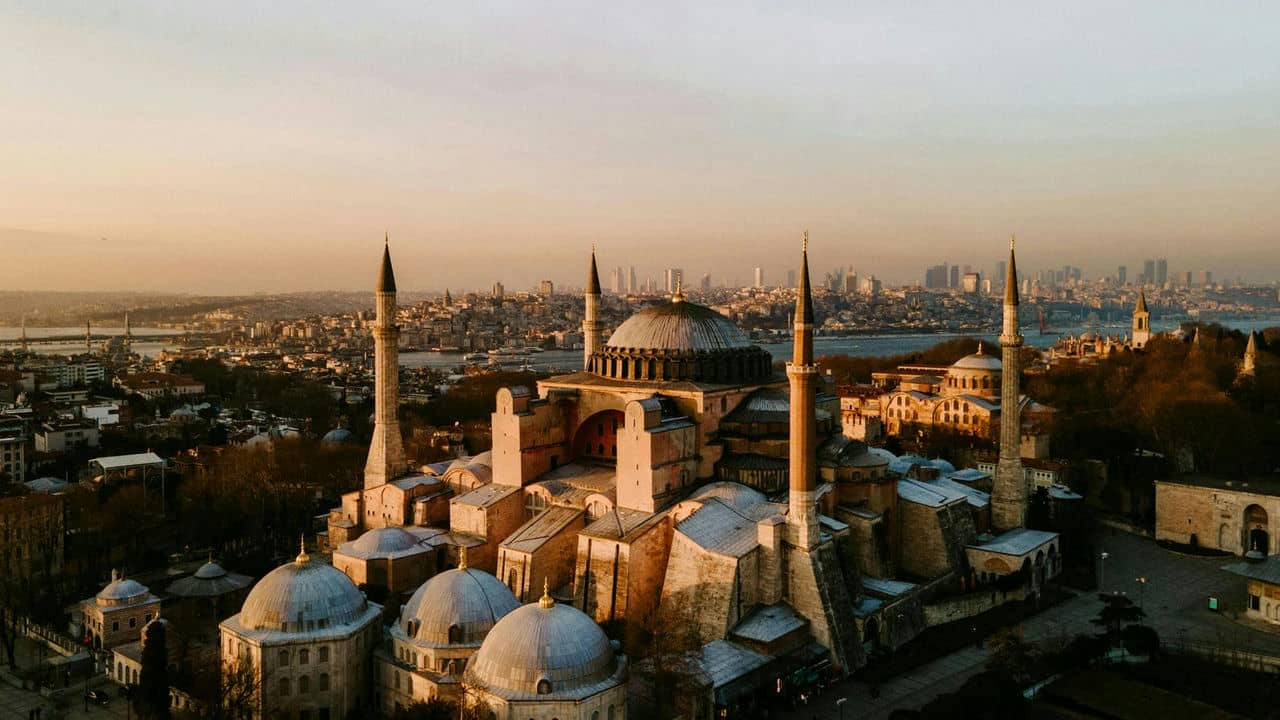
How has Hagia Sophia influenced the design of other buildings in Turkey?
The Hagia Sophia influenced the design of other buildings in Turkey in 4 ways. Firstly, numerous Ottoman-era mosques in Turkey were affected by the architectural style of the Hagia Sophia. The conversion of the Hagia Sophia into a mosque in the 15th century served as a model for subsequent mosque designs. These mosques often incorporated elements such as large central domes, supporting arches, and minarets, drawing inspiration from the architectural features of the Hagia Sophia. Secondly, the Hagia Sophia’s design influenced the construction of other Byzantine churches in Turkey. The success and grandeur of the Hagia Sophia motivated the construction of Byzantine churches with similar architectural elements. These churches, such as the Chora Church in Istanbul, adopted the use of domes, arches, and intricate mosaics, showcasing the influence of the Hagia Sophia’s design on subsequent ecclesiastical structures. Thirdly, the impact of the Hagia Sophia’s design can also be seen in modern Turkish architecture. The fusion of Byzantine and Islamic architectural elements in the Hagia Sophia has inspired contemporary architects in Turkey. Some modern buildings in the country exhibit a combination of these influences, incorporating features such as domes, arches, and decorative motifs reminiscent of the Hagia Sophia. Lastly, the Hagia Sophia’s influence extends to international architecture. The monument’s distinctive architectural style has inspired buildings around the world. The Basilica of the National Shrine of the Immaculate Conception in Washington, D.C., draws inspiration from the Hagia Sophia’s central dome and Byzantine design elements.
What purpose does the Hagia Sophia serve, and how does the design help?
The Hagia Sophia is a significant religious and cultural monument with a design that supports its purpose in 3 ways. Firstly, the Hagia Sophia has historically served as a place of worship for Christianity and Islam. It was originally constructed as a Byzantine cathedral and later became a mosque during the Ottoman Empire. Today, it functions as a museum. The design of the Hagia Sophia accommodates its dual religious heritage, featuring elements from both Christian and Islamic architecture. The inclusive design allows visitors to appreciate the historical and cultural significance of the monument. Secondly, the design of the Hagia Sophia creates a sense of awe and reverence. The monumental central dome, supported by arches and pendentives, draws the gaze upward, symbolizing the connection between heaven and earth. The spacious interior and abundant natural light, achieved through the clever placement of windows and openings, evoke a sense of transcendence and serenity. The design elements work harmoniously to create an atmosphere conducive to prayer, contemplation, and spiritual reflection. Lastly, the Hagia Sophia’s design facilitates displaying and preserving its rich artistic and architectural heritage. The monument features intricate mosaics, marble decorations, and calligraphy, showcasing the craftsmanship of different eras. The spacious interiors and strategic arrangements of these artworks allow visitors to appreciate their beauty and historical significance. The design also provides a functional layout for museum exhibitions, ensuring the preservation and accessibility of the Hagia Sophia’s cultural treasures.
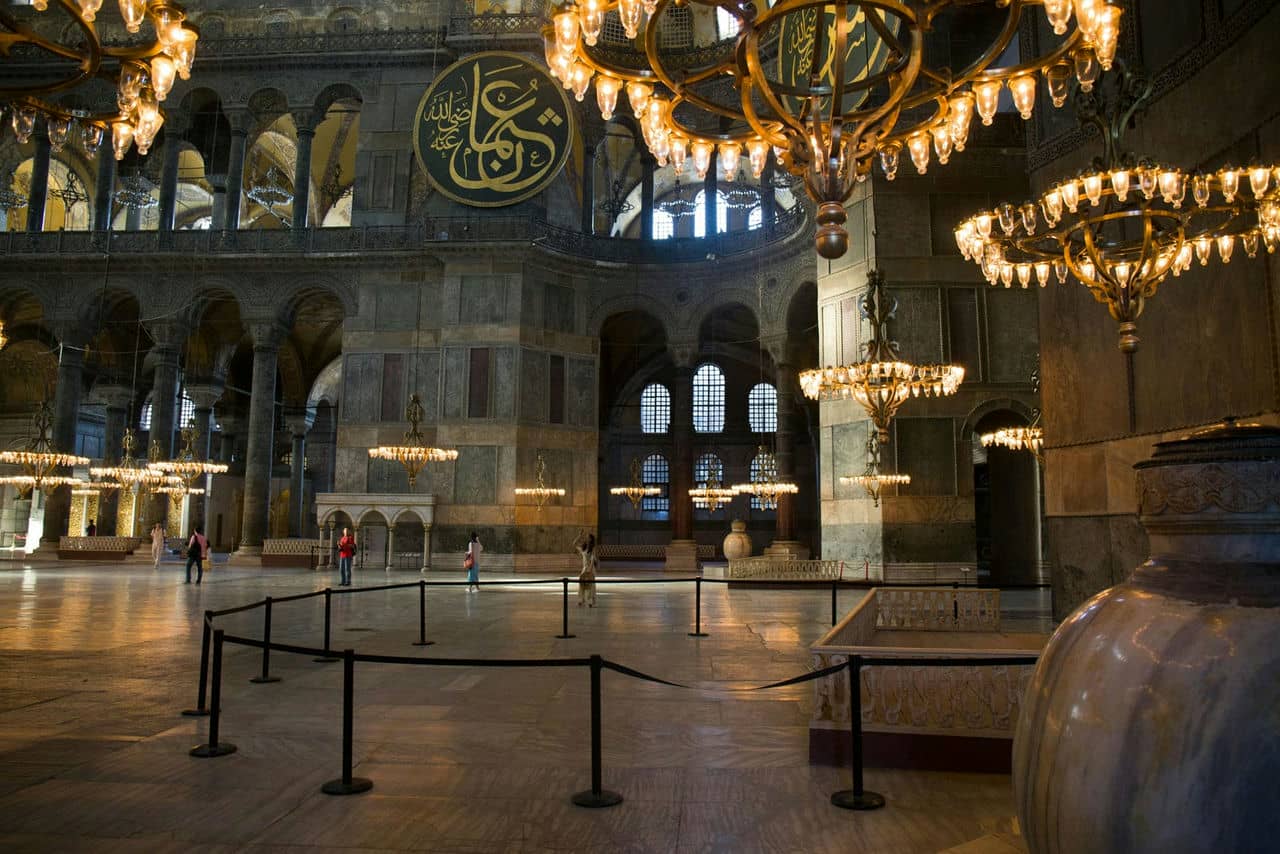
How is the Hagia Sophia maintained?
The Hagia Sophia is maintained through regular upkeep and restoration efforts to ensure its preservation and structural integrity. Firstly, routine maintenance is conducted to address day-to-day wear and tear. Cleaning and dusting of the interior surfaces, including the mosaics and marble decorations, are carried out to prevent the accumulation of dirt and debris. Regular inspections are conducted to identify any structural issues or areas needing repair. Maintenance teams monitor the condition of the building, including its roof, walls, and foundation, and undertake necessary repairs to prevent further damage. Secondly, restoration projects are undertaken to address more extensive structural issues and preserve the historical features of the Hagia Sophia. These restoration efforts involve experts in architecture, engineering, and art conservation. Restorers work to repair damaged sections, reinforce weakened structures, and restore artworks and decorative elements. The goal is to maintain the authenticity and historical integrity of the monument while ensuring its long-term preservation. Lastly, the Hagia Sophia benefits from ongoing research and documentation to inform maintenance and restoration practices. Scientific methods, such as architectural surveys, material analysis, and documentation of historical elements, aid in understanding the building’s deterioration and guiding appropriate conservation measures. The research provides valuable insights into the monument’s history and informs decision-making processes related to its maintenance and restoration.
How does the Hagia Sophia reflect cultural and contextual relevance in its design?
The Hagia Sophia reflects cultural and contextual relevance in its design in 4 ways. Firstly, the Hagia Sophia’s design reflects its time’s cultural and religious context. It was originally constructed as a Byzantine cathedral and was influenced by Byzantine architectural traditions. The central dome, arches, and intricate mosaics embody the Byzantine aesthetic and the importance of divine transcendence in Christian worship. Later, the conversion of the Hagia Sophia into a mosque incorporated Islamic architectural elements, such as minarets and mihrabs, reflecting the cultural and religious shift of the Ottoman Empire. Secondly, the Hagia Sophia’s design demonstrates its significance as a symbol of power and grandeur. The massive central dome, supported by arches and pendentives, conveys a sense of awe and magnificence. The size and scale of the building reflect the ambition and technical expertise of the Byzantine architects who constructed it. The interior space, filled with natural light and adorned with intricate decorations, creates an atmosphere of splendor and reverence. Thirdly, the Hagia Sophia’s design incorporates influences from various cultures, reflecting its role as a crossroads between East and West. Byzantine, Islamic, and classical influences are evident in its architectural and decorative elements. The amalgamation of styles showcases the cultural exchange and artistic synthesis during the Byzantine Empire. Lastly, the contextual relevance of the Hagia Sophia’s design lies in its adaptive reuse as a museum. Transforming the monument into a museum serves as a cultural and historical hub, showcasing the fusion of religious and architectural traditions. The design allows for displaying and interpreting its diverse heritage, giving visitors a deeper understanding of the monument’s historical and cultural significance.
What architectural trend or movement does the Hagia Sophia represent?
The Hagia Sophia represents the architectural trend of Byzantine architecture. Byzantine architecture is known for its emphasis on grandeur, religious symbolism, and domes. The Hagia Sophia’s design showcases these characteristics through its monumental central dome, supported by arches and pendentives, which create a sense of awe and transcendence. The intricate mosaics, marble decorations, and other artistic elements reflect the Byzantine aesthetic and craftsmanship. The Hagia Sophia’s architectural influence extends beyond the Byzantine period. Its conversion into a mosque during the Ottoman Empire introduced Islamic architectural elements, such as the addition of minarets and mihrabs. The fusion of Byzantine and Islamic architectural styles demonstrates the cultural and historical context in which the monument evolved.
What are the challenges faced during the restoration of the Hagia Sophia?
There are 4 major challenges faced during the restoration of the Hagia Sophia. Firstly, one of the challenges faced during the restoration of the Hagia Sophia was preserving its historical elements. The monument contains valuable mosaics, marble decorations, and other artistic features that require meticulous care. The restoration teams must employ delicate techniques to clean, repair, and protect these intricate details while maintaining their authenticity and historical integrity. Secondly, the complex architecture of the Hagia Sophia poses another challenge. The monument’s large central dome, arches, and intricate structural elements require engineering and architectural restoration expertise. The restoration teams must carefully analyze the building’s structural stability and address any structural issues or degradation. Balancing preserving the original design while implementing necessary repairs and reinforcements is a complex task that demands careful planning and execution. Thirdly, the Hagia Sophia’s transformation into a museum presents visitor management and conservation challenges. The monument attracts many visitors, which can place stress on its physical structure and delicate artwork. Preservation strategies must be implemented to mitigate the impact of foot traffic, temperature fluctuations, and humidity levels. The restoration teams must find ways to accommodate visitor access while ensuring the safety and preservation of the monument. Lastly, securing the necessary funding for restoring the Hagia Sophia is an ongoing challenge. Restoration projects of this magnitude require substantial financial resources. The costs of research, conservation, and structural repairs can be significant. Securing public and private funding and coordinating international support is crucial to ensure restoration efforts’ sustainability and the monument’s long-term preservation.
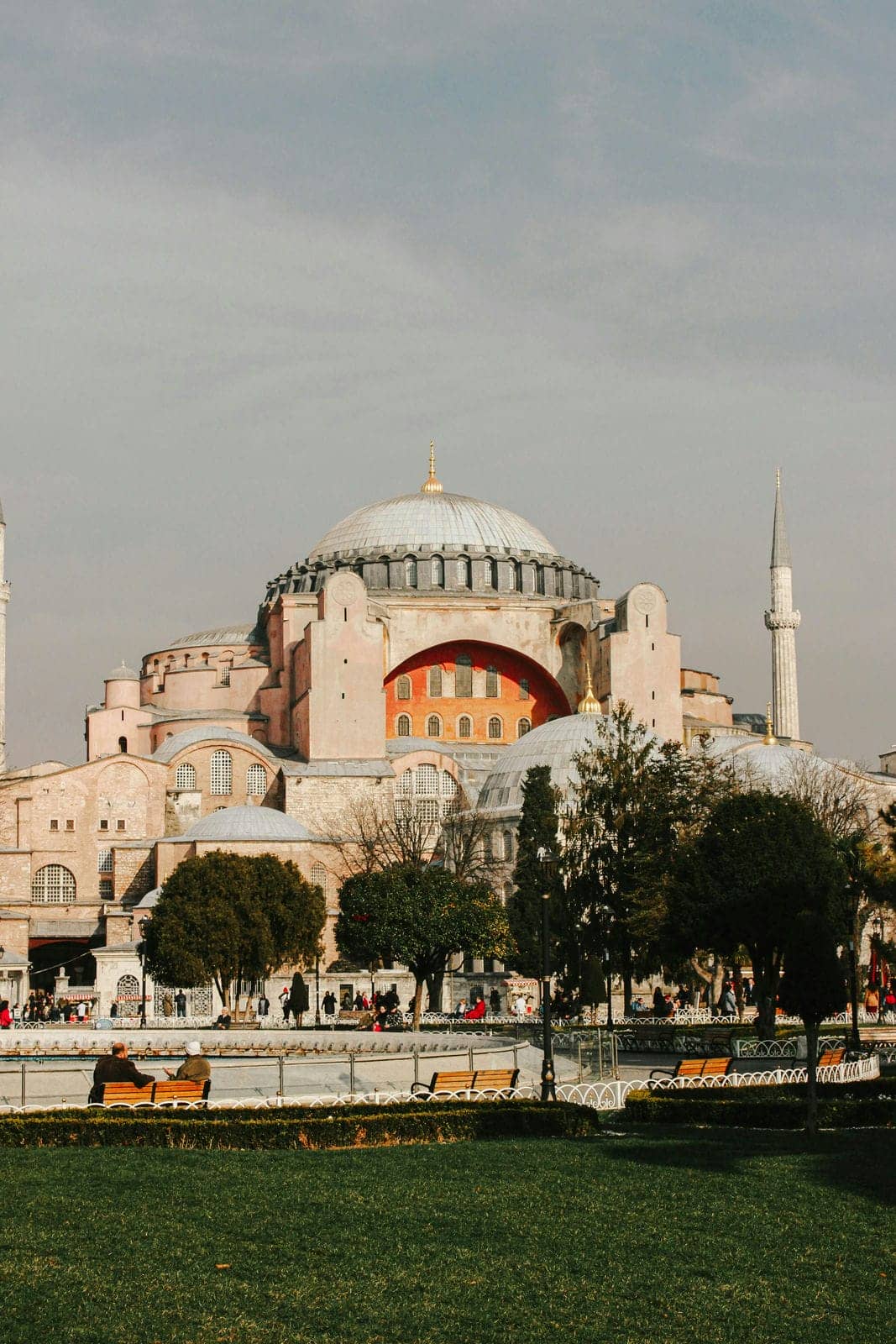
How does the Hagia Sophia comply with contemporary safety and accessibility standards?
The Hagia Sophia complies with contemporary safety and accessibility standards in 4 ways. Firstly, the Hagia Sophia has implemented safety measures to meet modern standards. Fire detection and suppression systems have been installed throughout the building to mitigate the fire risk and protect its historical and cultural treasures. Emergency exits and evacuation routes have been strategically placed to ensure the safe evacuation of visitors in case of emergencies. Additionally, the monument has implemented measures to address structural stability, such as reinforcing weakened areas and conducting regular inspections to identify and address potential safety hazards. Secondly, the Hagia Sophia has enhanced accessibility for all visitors. Ramps and elevators have been installed to provide wheelchair accessibility and facilitate movement for individuals with mobility challenges. Accessible restrooms have been added to accommodate the needs of visitors with disabilities. Signage and wayfinding systems have been improved to aid navigation and communicate important information. These accessibility measures strive to create an inclusive environment, allowing people of diverse abilities to fully experience and appreciate the cultural and historical significance of the monument. Thirdly, the Hagia Sophia has integrated modern technologies to enhance safety and accessibility. Video surveillance systems and security personnel are in place to monitor the premises and ensure the security of visitors. Information and communication technologies, such as audio guides and multilingual signage, have been implemented to provide visitors with informative and engaging experiences. These technological advancements contribute to a safer and more accessible visit, allowing visitors to engage with the monument’s history and architectural beauty in a contemporary and convenient manner. Lastly, the Hagia Sophia complies with modern safety and accessibility standards through continuous improvement and adaptation. Regular reviews and updates are conducted to ensure compliance with evolving regulations and best practices. Training and awareness programs are implemented to educate staff and volunteers on safety protocols and accessibility guidelines.
Are there any specific tours for architects or architecture enthusiasts to visit Hagia Sophia?
Yes, there are specific tours for architects or architecture enthusiasts to visit the Hagia Sophia. • Historical Tour offers expert insights and fascinating stories about the construction, transformations, and historical context of Hagia Sophia from a knowledgeable historian. The tour covers the exterior and interior features of Hagia Sophia, such as the dominant domes, the minarets, the courtyards and gardens, the impressive nave, the stunning mosaics, and the cultural fusion of Christian and Islamic elements. The tour lasts 90 minutes and costs $26 (€23.66, £22.62) per person. Byzantine Istanbul Tour focuses on the Byzantine splendors of Istanbul, including the Hagia Sophia, the Hippodrome, and the Basilica Cistern. The tour explores the architectural and artistic wonders of the Byzantine era and the political and religious history of the empire. The tour is led by a Byzantine history and art scholar who will provide in-depth commentary and answer questions. The tour lasts three hours and costs $97 (€88.27, £84.39) per person.
What lessons can architects learn from the design and construction of the Hagia Sophia?
There are 4 lessons that architects can learn from the design and construction of the Hagia Sophia. Firstly, the Hagia Sophia teaches architects the importance of innovative structural design. Its iconic central dome, supported by pendentives and arches, showcases a pioneering engineering solution that created a vast open space. Architects can learn from the Hagia Sophia’s structural ingenuity to explore innovative ways to achieve large, airy interiors while maintaining structural stability and integrity. Secondly, the Hagia Sophia demonstrates the power of architectural symbolism. The monument’s design reflects the Byzantine Empire’s religious and imperial aspirations, with its grand scale, impressive domes, and intricate mosaics. Architects can learn from this example to incorporate symbolic elements into their designs, using architecture to express cultural, social, or historical narratives, evoking emotions and creating a deeper connection with the users and the surrounding environment. Thirdly, the Hagia Sophia highlights the significance of adaptive reuse. Throughout history, the monument has changed functions, from a church to a mosque and eventually a museum. Architects can learn from this adaptive reuse approach, understanding the value of preserving historical structures and finding creative ways to repurpose them for contemporary use. The Hagia Sophia’s transformation demonstrates the potential for architectural interventions that respect and honor the existing built environment. Lastly, the Hagia Sophia emphasizes the importance of meticulous craftsmanship and attention to detail. The monument’s intricate mosaics, marble decorations, and architectural ornamentation exemplify the skill and dedication of the craftsmen involved in its construction. Architects can learn from this commitment to craftsmanship, recognizing that the quality of materials, attention to detail, and the pursuit of excellence are essential to creating enduring and inspiring architectural works.
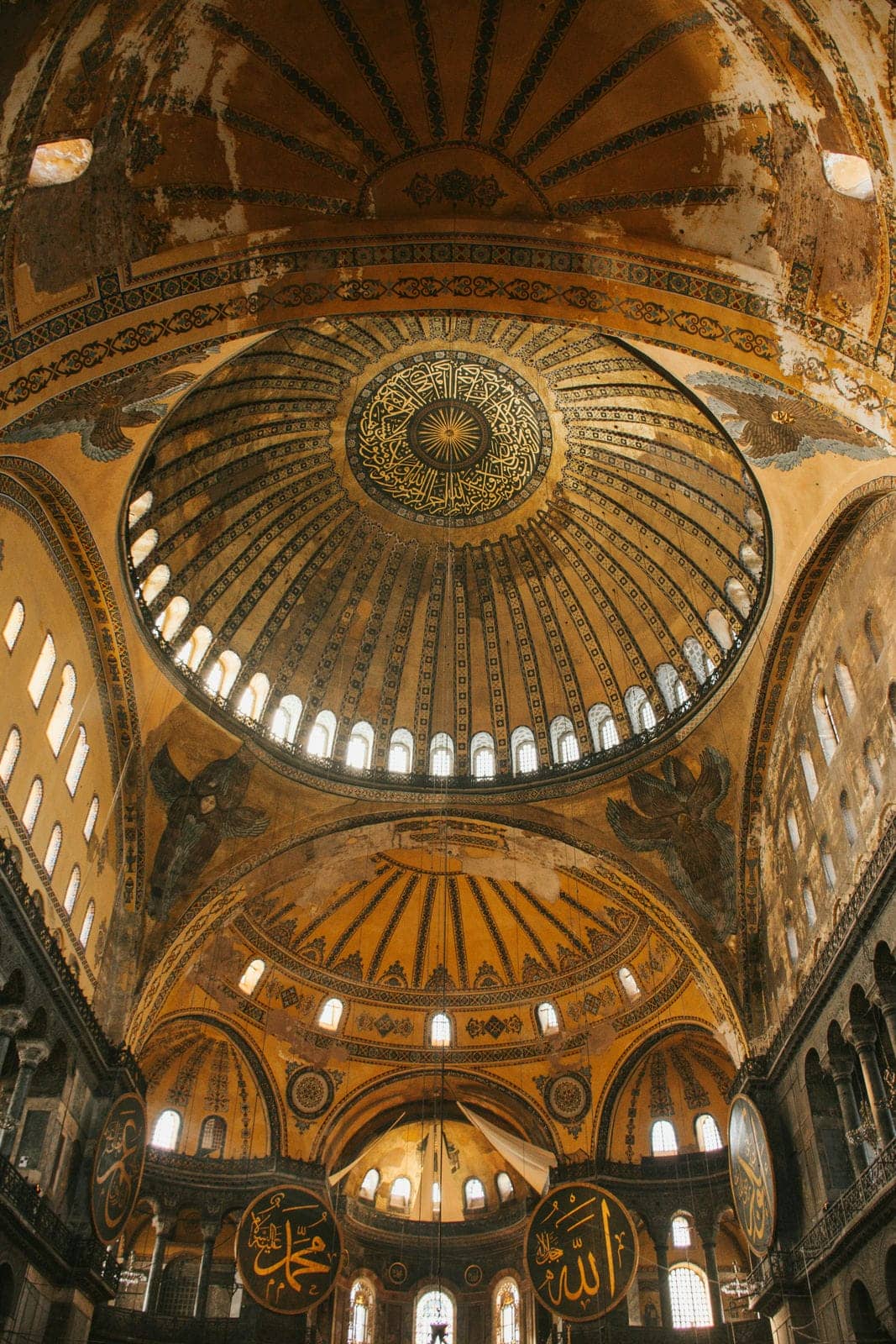
What are the best architectural landmarks to visit as an architect?
Listed below are the best architectural landmarks to visit as an architect:
- Sagrada Familia: The Sagrada Familia is an iconic basilica located in Barcelona, Spain. Designed by popular architect Antoni Gaudí, it is known for its unique and intricate architectural style that combines Gothic and Art Nouveau influences. The basilica has been under construction since 1882 and is still ongoing, making it a fascinating example of long-term architectural vision and dedication. Visitors can admire the stunning facades, soaring towers, and intricate details that make the Sagrada Familia a must-visit landmark for architects and enthusiasts alike.
- Taj Mahal: The Taj Mahal is a UNESCO World Heritage site in Agra, India. Built in the 17th century by Emperor Shah Jahan as a mausoleum for his beloved wife, it is considered one of the most beautiful examples of Mughal architecture. The Taj Mahal features intricate marble inlay work, symmetrical design elements, and a stunning white marble exterior. Its harmonious proportions and elegant details make it a masterpiece of architectural craftsmanship, attracting millions of visitors annually.
- Sydney Opera House: The Sydney Opera House is an iconic performing arts center in Sydney, Australia. Designed by Danish architect Jørn Utzon, it is known for its distinctive sail-like roof structure. The complex houses multiple performance venues and symbolizes modern expressionist architecture. Its innovative design and engineering challenges make it a significant landmark in architectural history. Visitors can take guided tours to explore the interior spaces and learn about the architectural concepts behind this world-famous structure.
- Guggenheim Museum Bilbao: The Guggenheim Museum Bilbao is a contemporary art museum in Bilbao, Spain. Designed by architect Frank Gehry, it is recognized for its striking, curvilinear form and titanium-clad exterior. The museum’s unconventional design pushes the boundaries of traditional architecture, creating a visually captivating and highly acclaimed landmark. Inside, visitors can experience a diverse collection of modern and contemporary art. The Guggenheim Museum Bilbao has revitalized the city, symbolizing urban regeneration through architecture.
- Fallingwater: Fallingwater is a residential house located in Mill Run, Pennsylvania. Designed by architect Frank Lloyd Wright, it is an iconic example of organic architecture that integrates seamlessly with its natural surroundings. The house is built over a waterfall and features cantilevered balconies and open spaces that blur the boundaries between indoors and outdoors. Fallingwater showcases Wright’s principles of harmony between architecture and nature, making it a significant landmark for architects interested in sustainable design.
- St. Peter’s Basilica: St. Peter’s Basilica is a major basilica in Vatican City, Rome. Designed by known architects, including Michelangelo and Gian Lorenzo Bernini, it is the largest church in the world and a masterpiece of Renaissance and Baroque architecture. The basilica’s grandeur is evident in its vast dome, intricate mosaics, and numerous works of art. Architects can appreciate the meticulous detailing and craftsmanship that went into creating this architectural marvel. Visitors can explore the interior, including the famous St. Peter’s Square, and marvel at its architectural and artistic splendor.
- The Louvre: The Louvre is a world-known art museum in Paris, France. Originally a medieval fortress, it was transformed into a grand palace and later became a museum. The Louvre is celebrated for its iconic glass pyramid entrance, designed by architect I.M. Pei. The museum houses an extensive collection of art and historical artifacts, including famous works such as the Mona Lisa. Architects can appreciate the museum’s architectural evolution, from its historic roots to the modern additions that have transformed it into a cultural landmark.
- Burj Khalifa: The Burj Khalifa is a skyscraper in Dubai, United Arab Emirates. Designed by the architectural firm Skidmore, Owings & Merrill, it is the tallest building in the world, standing at 2,717 feet (828 meters). The Burj Khalifa’s sleek and futuristic design features a stepped silhouette and a reflective glass facade. Its engineering marvels, such as the advanced structural systems and high-speed elevators, make it an impressive landmark for architects interested in tall building design. Visitors can enjoy panoramic views of Dubai from the observation decks on the upper floors.
- The Parthenon: The Parthenon is an ancient temple atop the Acropolis hill in Athens, Greece. Built in the 5th century BCE, it symbolizes classical Greek architecture and is one of the most influential buildings in Western history. The Parthenon showcases the Doric order with its iconic columns and pediments adorned with marble sculptures. Its harmonious proportions and refined architectural details demonstrate the principles of balance and symmetry. Architects can study the Parthenon’s design to understand the foundations of classical architecture and its enduring impact on architectural aesthetics.
- The Great Wall of China: The Great Wall of China is an ancient fortification that stretches across northern China. It is an architectural marvel and a UNESCO World Heritage site built over centuries. The wall showcases various construction techniques, including brick, stone, and rammed earth. Its strategic design incorporates watchtowers, battlements, and defensive features. The Great Wall’s vast scale and historical significance make it a remarkable landmark for architects interested in the intersection of architecture and military engineering. Visitors can explore different sections of the wall and admire the panoramic views of the surrounding landscapes.


